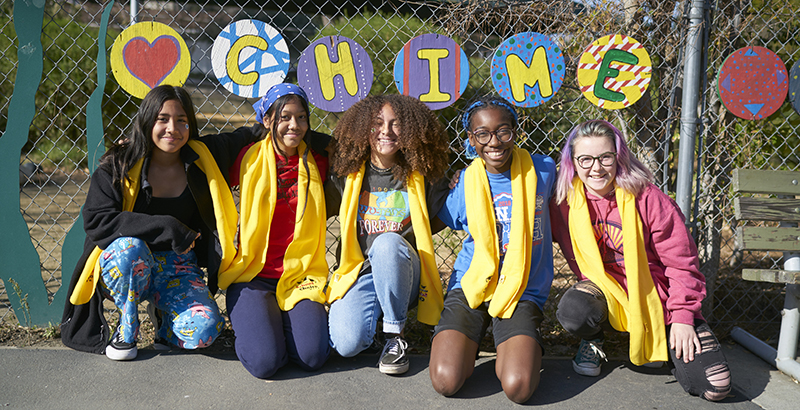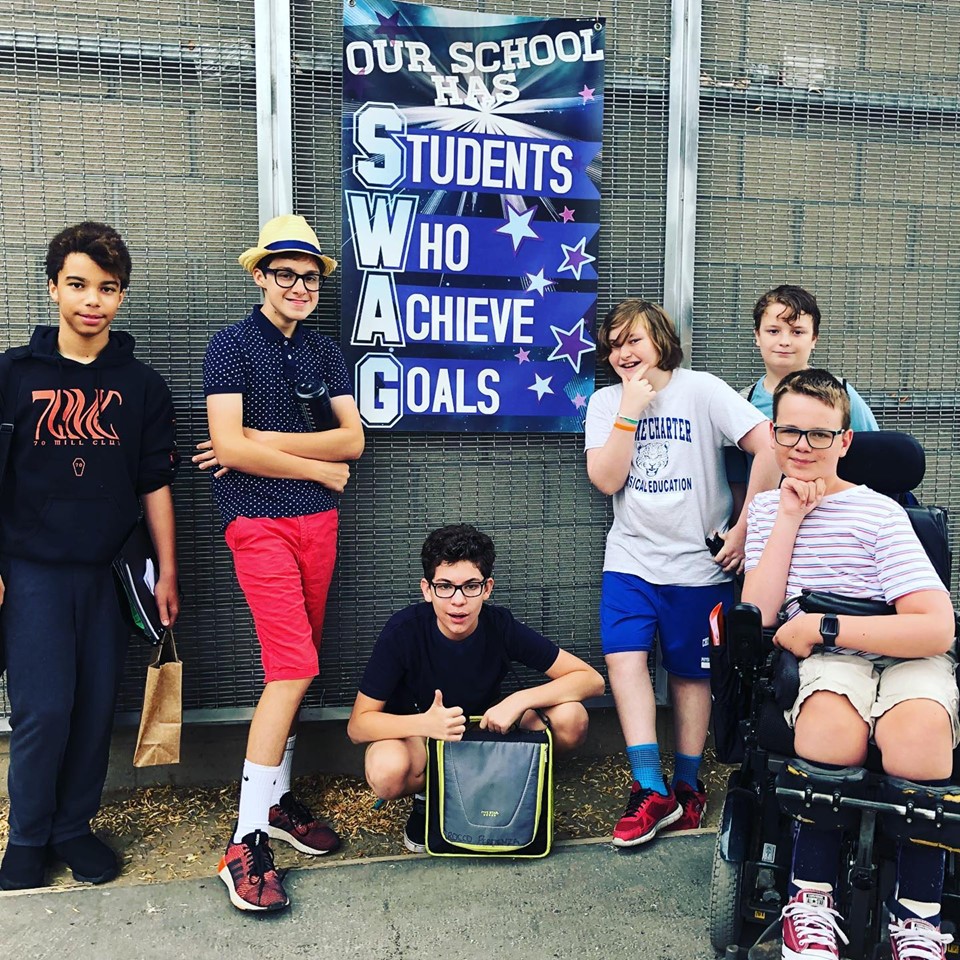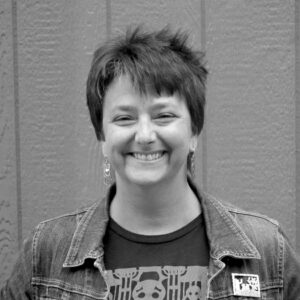All In: A Southern California School With a Radical — and Successful — Vision for Students With Disabilities

Over the next several weeks, The 74 will be publishing stories reported and written before the coronavirus pandemic. Their publication was sidelined when schools across the country abruptly closed, but we are sharing them now because the information and innovations they highlight remain relevant to our understanding of education.
Author’s note: CHIME Institute’s Schwarzenegger Community School has moved to distance learning, supplying an array of digital supports to students with needs ranging from keeping up with therapeutic services to gifted enrichment opportunities.
Making his way up the ramp that connects the first and second stories of his middle school, Erin Studer turns and gestures back at the long, gently sloped passage.
“You just walked up a quarter of a million dollars of philosophy,” he chortles, clearly having delivered this object lesson before at the school he leads, the CHIME Institute’s Schwarzenegger Community School, located in Woodland Hills, California.
What Studer wants visitors to see from the top of the ramp is not just the campus’s collection of sunny brick bungalows, but evidence — literally concrete — of the school community’s core belief. Everyone at CHIME, whether walking or using a motorized chair or other mobility support, can move up and down the ramp together.

This may not seem particularly radical, unless you are a schoolchild with a disability who is eager to fit in with your typically developing peers. Then, every moment in which your differences don’t stand out — when you aren’t, say, receiving speech therapy in an isolated room while your friends are enjoying art, or wishing you got to read the same novel as the gifted kids — is a big deal.
Opened 19 years ago on the west side of the San Fernando Valley, the K-8 school is the outgrowth of an effort at nearby California State University-Northridge to find better ways of supporting children with disabilities. The program was started to find early interventions for preschoolers, but as the kids grew, their families wanted a school where they could enroll their children with special needs, their typically developing children, their gifted students or their children who fit more than one of those descriptions.
Unlike traditional special education, which is often literally a place to which children with special needs are sent, CHIME’s families and staff envisioned a school where every student was a full participant in the community. No student is pulled out of the classroom for special assistance. Everything from the furniture to the lesson plans has been designed to enable students of all capacities to thrive in the same classroom.
This full-inclusion model is paying off. Despite having a higher-than-average special education population — and a much larger number of children with moderate to profound disabilities — CHIME’s students score 14 percentage points higher than state averages for all kids on math and reading exams.
Contrast this with the generally dismal state of special education. Nationwide, just 20 percent of students with disabilities pass state math and reading assessments, even though research estimates that given the right support, 90 percent are capable of performing at grade level.
The mere existence of a school where even children with profound disabilities are thriving is a game changer, says Amy Hanreddy, a former CHIME teacher and administrator who is now a special education professor at Cal State. She oversees a partnership between the university and the school, which hosts student teachers and shares promising practices with other schools and teacher-training programs.
“One of our greatest challenges is we lack vision for individuals with disabilities and what they are capable of,” says Hanreddy. “That’s why CHIME is so important — especially for people who don’t work there. It’s a place they can go and see what’s possible.”
Built a few years ago as part of an addition as the school grew, the ramp was hotly debated. The architects counseled saving the money — after all, there would be both stairs and an elevator. But Studer was firm: “Inclusion is the lens through which we see our budget, how we decide our calendar, how we make decisions.”
The ramp is a prime example of universal design, a term coined by architects to describe the creation of an environment that’s accessible to all. An extension of that philosophy, universal design for learning, means creating flexible ways for students to access information and demonstrate their knowledge.
Currently, CHIME enrolls 790 students ranging from pre-kindergarten to eighth grade, drawn from 44 zip codes in north Los Angeles via lottery. One-fourth of students are economically disadvantaged, and 20 percent are learning English. Typically, the school receives 1,500 applications a year for about 150 spots.
Students with disabilities receive no special enrollment preference, but they are overrepresented in the applicant pool because of word of mouth about the school’s success. About 20 percent of students receive special education services. Sixty have moderate to severe disabilities, five times the rate statewide. Ten have Down syndrome.
“This is really one of a few places in Los Angeles where [families of students with disabilities] can have their children fully included in an environment where they are accessing the curriculum with their typically developing peers,” says Studer.
CHIME was born the Children’s Center Handicapped Integration Model Educational Project, a three-year, federally funded Cal State initiative. In 1990, two special education professors at the university turned the project into a stand-alone nonprofit, the CHIME Institute, which opened first a preschool and a year later a program for infants and toddlers.
What the project showed was that delivering early interventions in a center also attended by families of typically developing children wrought bigger gains than sending specialists to individual kids’ homes. As the original students grew older, their parents pushed the centers’ leaders to open a school.
“It was a unique joy to them to bring all of their kids to the same school and have common experiences among siblings that some families take for granted,” recalls Studer. “For some families with a child with a disability and one typically developing, they can both have ‘Mr. Thomas’ and both talk about ‘Mr. Thomas.’”
In 2001, the institute opened a public charter elementary school, which eventually grew into a K-8. Along the way, the name CHIME, originally the shorthand for the Cal State experiment, became a different acronym: Community Honoring Inclusive Model Education.
In a traditional school, students with disabilities have Individualized Education Programs, or IEPs, outlining academic and developmental goals and specifying the services that will be provided to meet them. Typically, an IEP quantifies these services by minutes of support a child must receive — an effort to hold schools accountable for delivering enough assistance.
Federal law says special needs students must be served in the least restrictive environment, which means they are entitled to spend as much of the school day as possible with their peers in general education classrooms. Students’ special ed minutes, meanwhile, are frequently spent outside the regular classroom. The more pronounced the need, the more time a child spends in a segregated setting.
Further complicating matters, general education teachers typically receive meager training in special education and have little idea how to make their lessons and materials accessible to students with learning differences. To get appropriate support, students with IEPs often must leave class for some or all of the school day.
Often, this means missing electives and enrichment opportunities. Rarely does it allow students with IEPs the chance to participate in advanced lessons reserved for gifted and talented children.
The truth is, though, that strategies used in special ed can benefit other kids in general education classes. For example, there is growing awareness that most typically developing students need the type of literacy instruction that most schools reserve for children with dyslexia.
Finally and crucially, a special needs student’s presence in a regular classroom does not guarantee that the classroom is inclusive, academically or socially.
“Mainstreaming is about having someone physically be somewhere,” says Studer. “But that doesn’t mean that participation is meaningful. Inclusion is meaningful participation in the school and classroom community.”
Participation is also a powerful motivator, he notes. A student who has trouble verbalizing, for instance, will get more out of speech therapy when it is delivered in an inclusive classroom, woven into the lesson the entire class is participating in.
“There will be 100 times a day where they will want so badly with their typically developing peers to speak,” says Studer. “A student who has a mean word utterance of two words will suddenly have seven.”
At CHIME, it’s common to see multiple adults in classrooms as general and special education teachers, therapists, specialists and special education paraprofessionals help students with an array of needs work together on the same lesson. Unlike some other schools that use co-teaching, here the special education teacher does not act as a support for the regular teacher or focus on one or more students who have been pulled aside.
If a class includes a child with a specific need — for occupational therapy, say — the support is built into the lesson or activity the whole class engages in. Far from burdening general education students, the services translate to extra skills.
Each staff team creates its curriculum, making the accommodations and modifications its students will need. Adapted materials are kept either online in shared files or laminated and shelved, for repeated use. For example, CHIME has seven versions of Scott O’Dell’s Island of the Blue Dolphins, which is required reading for California’s fourth-graders. In addition to the normal bound book, there are copies with large print, with words highlighted in different colors and with simple explanations of basic concepts. There may be as many — or more — options for students to demonstrate comprehension.
“At the heart of universal design is thinking about the students we are about to teach,” says Cal State’s Hanreddy. “Who are they and what are their needs?”
Students with disabilities or learning differences aren’t relegated to less challenging classes, she adds: “They don’t say, ‘We don’t include [those] students in algebra.’ They say, ‘We are going to problem-solve how to include them.’”
Gifted and talented students similarly receive tailored services in the regular classroom, rather than being pulled out. “We should look at you as an individual who needs their curriculum enriched and complexified,” says Studer. “That can really be used for anybody.”
This is the opposite of the popular conception of personalized learning. “Individualization in the classroom doesn’t mean I create 30 plans,” he says. “It means I create a plan that has enough flexibility that you can find your own pathway within it.”
Planning starts weeks in advance, with time built into teachers’ schedules and a mandatory daily 20-minute debrief. Team members are accountable to one another for the collaborative lesson plans — a major difference from traditional schools where special ed and general ed teachers work separately.
This joint responsibility for making sure materials and lessons are accessible to all students represents a major reorganization of how special ed and general education teachers typically divide their work. When a student with a disability spends most of the day in a conventional regular education classroom, frequently the general education teacher does not know what services the special education teacher may supply during the time the student is pulled out of class.
But when they work together, the special ed teacher can introduce the general ed teacher to techniques that are valuable for students who are struggling but not disabled, and accommodations become part of the curriculum.
It’s also a major shift away from the traditional means of gauging whether the needs of students with disabilities were met, which is to verify that they received the minutes of service called for in their IEP, not whether those minutes led to growth.
“We have let minutes become a proxy for quality, and that’s not good at all,” says Studer. “If we insist on staying within the box of checking minutes, we’re never going to drive quality in special education.”
In keeping with its goal of being a laboratory for innovations, every year CHIME hosts 15 to 20 student teachers and two dozen students doing fieldwork from its Cal State partner. This serves as a talent pipeline for the school and a mechanism for ensuring that future teachers, in both special and general education, carry with them an understanding of how students with special needs can participate in regular classrooms.
“One of the most important things CHIME can give them is the vision of what’s possible,” says Hanreddy, acknowledging that those new teachers likely will have to serve as “agents of change” in the conventionally structured schools where most will go on to work. “We have a model of what [effective] practices are, what they look like, so we can talk about what that looks like in their own context.”
In addition to visitors from Southern California school districts, CHIME often hosts teams from teacher training programs and educators from other countries — at the core of the school’s mission.
Former CHIME teachers have opened two other Southern California schools using similar models: Tomorrow’s Leadership Collaborative in Orange and the WISH elementary, middle and high schools in Los Angeles. And Studer says his families would like to see CHIME open a high school — an expensive proposition.
But he doesn’t envision creating a network of schools, the path often taken by successful charter schools. “We don’t think the pathway to making more inclusive schools is to make more CHIMEs,” he says. “If we really want to move the needle, isn’t the goal to make other schools more inclusive?”
And, of course, each new student who enrolls in the school brings a particular blend of strengths and needs, creating fresh opportunities to find new ways of being inclusive, says Studer: “As much as we have grown, we’re still a collection of families who have come together to educate our kids in a way we believe in.”
Get stories like these delivered straight to your inbox. Sign up for The 74 Newsletter

;)
